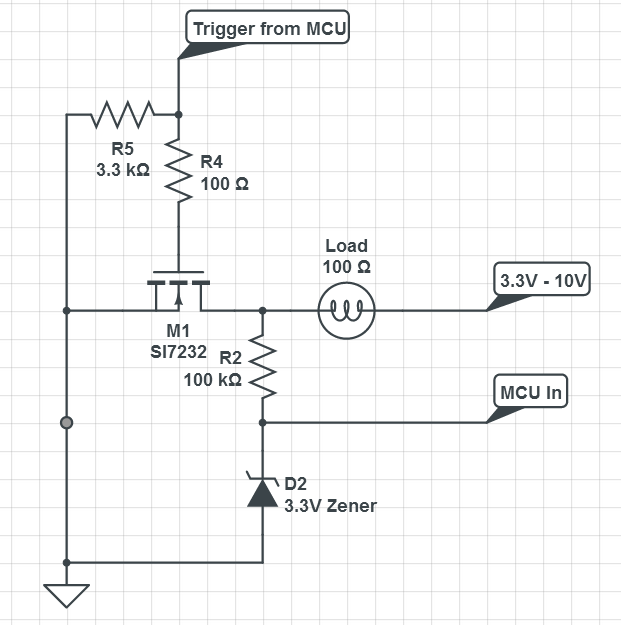9V into Prop using a Zener
Hi All,
This could be in the general electronics forum, but seeing as how im using a prop I might as well put it here
Below is a schematic showing how I have currently designed my circuit. The load is low resistance pyro, and I need to find a way to check continuity through it while allowing very little current to flow unless the NFET is turned on, which will ignite the pyro.
Originally I had planned to use a 9V (lets say 10V) battery as the supply, which is there the voltage divider comes in before the Prop input, to drop 10V to around 3V.

Now I wish to allow a range of battery options, from a 3.7V to 10V. The voltage divider would drop the 3.7V to below the Logic high required for the prop, so I am considering a Zener diode, however I do not know much about them.
From what ive read only, I need to pick a zener with a zener voltage of 3.3V which will get rid of any voltage above 3.3V, so is my solution as simple as the below drawing? Is there anything else I need to consider so that I dont destroy the props input?
To preserver battery life I want very little current to flow through the load unless the NFET is turned on, hence the 100K resistor.

This could be in the general electronics forum, but seeing as how im using a prop I might as well put it here
Below is a schematic showing how I have currently designed my circuit. The load is low resistance pyro, and I need to find a way to check continuity through it while allowing very little current to flow unless the NFET is turned on, which will ignite the pyro.
Originally I had planned to use a 9V (lets say 10V) battery as the supply, which is there the voltage divider comes in before the Prop input, to drop 10V to around 3V.

Now I wish to allow a range of battery options, from a 3.7V to 10V. The voltage divider would drop the 3.7V to below the Logic high required for the prop, so I am considering a Zener diode, however I do not know much about them.
From what ive read only, I need to pick a zener with a zener voltage of 3.3V which will get rid of any voltage above 3.3V, so is my solution as simple as the below drawing? Is there anything else I need to consider so that I dont destroy the props input?
To preserver battery life I want very little current to flow through the load unless the NFET is turned on, hence the 100K resistor.



Comments
-Phil
Would I still need the 100K resistor? Or would the MOSFET gate essentially stop current flow through that path?
-Phil
I never use zeners for anything like this and the low voltage ones are too soft anyway. All you ever need to do is to limit the current to a level that the Prop's CMOS structure can handle. The quoted safe figure is <500ua, no problem at all with the 100K but I would make the divider more of a pull-down resistor instead and this needs to be around 220K so that even for a 3.7V input you will still have a good logic high (-->100K + 220K->GND). If you need to put more of a load on the pyro you can connect an output to an npn with a resistor in the collector to the load side and this way you can just sample briefly at safe but robust enough current levels.
The problem with shunting the current through the supply is when the Prop is drawing very little current, such as in reset and I have found that in this situation the supply rises up to around 4V or so and it seems to lock-up the Prop. To combat this I have had two LEDs in series with a 47R to provide a clamp but the simple 100K is already good.
Is there a max input voltage to the prop pins or is is solely determinded by current?